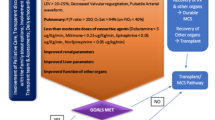Abstract
We describe a neonate with ductal-dependent congenital heart disease on extracorporeal membrane oxygenation (ECMO) for persistent pulmonary hypertension, who required markedly high doses of prostaglandin E1 (PGE1) to maintain patency of the ductus arteriosus: The effects of ECMO on the pharmacokinetics of PGE1 are discussed.


Similar content being viewed by others
References
Arai K (1995) The intrapulmonary metabolism of prostaglandin E1 in patients with pulmonary hypertension. Masui 44:536–541
Bartlett RH, Andrews AF, Toomasian JM, Haiduc NJ, Gazzaniga AB (1982) Extracorporeal membrane oxygenation for newborn respiratory failure: forty-five cases. Surgery 92:425–433
Buck ML (2003) Pharmacokinetic changes during extracorporeal membrane oxygenation:implications for drug therapy of neonates. Clin Pharmacokinet 42:403–417
Cox JW, Andreadis NA, Bone RC, et al. (1988) Pulmonary extraction and pharmacokinetics of prostaglandin E1 during continuous intravenous infusion in patients with adult respiratory distress syndrome. Am Rev Rev Respir Dis 137:5–12
Dagan O, Klein J, Gruenwald C, et al. (1993) Preliminary studies of the effects of extracorporeal membrane oxygenator on the disposition of common pediatric drugs. Ther Drug Monit 15:263–266
Dalton HJ, Siewers RD, Fuhrman BP, et al (1993) Extracorporeal membrane oxygenation for cardiac rescue in children with severe myocardial dysfunction. Crit Care Med 21:1020–1028
Gotteiner NL, Harper WR, Gidding SS, et al. (1997) Echocardiographic prediction of neonatal ECMO outcome. Pediatr Cardiol 18:270–275
Ishino K, Weng Y, Alexi-Meskishvili V, et al. (1996) Extracorporeal membrane oxygenation as a bridge to cardiac transplantation in children. Artif Organs 20:728–732
Kanter KR, Pennington G, Weber TR, et al. (1987) Extracorporeal membrane oxygenation for postoperative cardiac support in children. J Thorac Cardiovasc Surg 93:27–35
Noerr B, (1996) ECMO and pharmacotherapy. Neonatal Network 15:23–31
Siberry GK, Iannone R (2000) The Harriet Lane Handbook. A Manual for Pediatric House Officers. Mosby, St. Louis
Stolar CJ, Snedecor SM, Bartlett RH (1991) Extracorporeal membrane oxygenation and neonatal respiratory failure: experience from the extracorporeal life support organization. J Pediatr Surg 26:563–571
Tanke R, Daniels O, Van Heyst A, Van Lier H, Festen C (2002) The influence of ductal left-to-right shunting during extracorporeal membrane oxygenation. J Pediatr Surg 37:1165–1168
Wallgren EI (1962) Pulmonary and renal circulation in children with patent ductus arteriosus. Pre- and post-operative studies of thirty-four cases. Acta Paediatr 51(Suppl 138):1
Author information
Authors and Affiliations
Corresponding author
Rights and permissions
About this article
Cite this article
Stone, D., Frattarelli, D., Karthikeyan, S. et al. Altered Prostaglandin E1 Dosage During Extracorporeal Membrane Oxygenation in a Newborn with Ductal-dependent Congenital Heart Disease. Pediatr Cardiol 27, 360–363 (2006). https://doi.org/10.1007/s00246-005-1189-8
Published:
Issue Date:
DOI: https://doi.org/10.1007/s00246-005-1189-8




